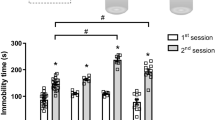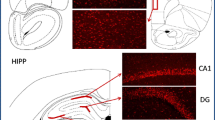Abstract
Rationale
Exposure to extreme stress has been suggested to produce long-term, detrimental alterations in the hypothalamic–pituitary–adrenal (HPA) axis leading to the development of mental disorders such as depression. Therefore, compounds that block the effects of stress hormones were investigated as potential therapeutics for depression.
Objectives
In the present study, we compared the potential antidepressant-like effects of four CRF antagonists, antalarmin, CP154,526, R121919, and LWH234 (at 3, 10, and 30 mg/kg i.p., 60 min prior to the forced swim test) and the corresponding effect on swim-induced HPA activation to better elucidate the relation between HPA activity and antidepressant activity.
Methods
The antidepressant-like effects of the CRF antagonists and known antidepressants were determined in the rat forced swim test, and blood samples were obtained before and after swimming for the evaluation of adrenocorticotropin-releasing hormone (ACTH) levels.
Results
Antalarmin, CP154,526, and R121919 did not produce antidepressant-like effects in the forced swim test although these compounds decreased swim-induced increases in ACTH to various extents. In contrast, LWH234 reduced immobility in the forced swim test, without altering the swim-stress-induced ACTH response. However, this compound antagonized restraint-induced ACTH release.
Conclusions
These data suggest that reducing stress-induced increases in HPA activity alone may not be sufficient to produce antidepressant-like activity; however, reductions in HPA activity may contribute to antidepressant actions of some treatments. In addition, it is proposed that CRF antagonists may alter differentially the HPA axis depending on the type of stressor used or behavioral measure evaluated.




Similar content being viewed by others
References
Alonso R, Griebel G, Pavone G, Stemmelin J, Le Fur G, Soubrié P (2004) Blockade of CRF1 and V1b receptors reverses stress-induced suppression of neurogenesis in a mouse model of depression. Mol Psychiatry 9:278–286
Borsini F, Lecci A, Sessarego A, Frassine R, Meli A (1989) Discovery of antidepressant activity by forced swimming test may depend on pre-exposure of rats to a stressful situation. Psychopharmacology 97:183–188
Britton DR, Varela M, Garcia A, Rosenthal M (1986a) Dexamethasone suppresses pituitary–adrenal but not behavioral effects of centrally administered CRF. Life Sci 38(3):211–216
Britton DR, Lee G, Dana R, Risch SC, Koob GF (1986b) Activating and ‘anxiogenic’ effects of corticotropin releasing factor are not inhibited by blockade of the pituitary–adrenal system with dexamethasone. Life Sci 39(14):1281–1286
Broadbear JH, Winger G, Rivier JE, Rice KC, Woods JH (2004) Corticotropin-releasing hormone antagonists, astressin B and antalarmin: differing profiles of activity in rhesus monkeys. Neuropsychopharmacology 29:1112–1121
Chaki S, Nakazato A, Kennis L, Nakamura M, Mackie C, Sugiura M, Vinken P, Ashton D, Langlois X, Steckler T (2004) Anxiolytic- and antidepressant-like profile of a new CRF1 receptor antagonist, R278995/CRA0450. Eur J Pharmacol 485:145–158
Deak T, Nguyen KT, Ehrlich AL, Watkins LR, Spencer RL, Maier SF, Licinio J, Wong M-L, Chrousos GP, Webster E, Gold PW (1999) The impact of the nonpeptidic corticotropin-releasing hormone antagonist antalarmin on behavioral and endocrine responses to stress. Endocrinology 140(1):79–86
De Bellis MD, Gold PW, Geracioti TD, Listwak SJ, Kling MA (1993) Association of fluoxetine treatment with reductions in CSF concentrations of corticotropin-releasing hormone and arginine vasopressin in patients with major depression. Am J Psychiatry 150(4):656–657
Detke MJ, Rickels M, Lucki I (1995) Active behaviors in the rat forced swimming test differentially produced by serotonergic and noradrenergic antidepressants. Psychopharmacology 121:66–72
Garcia-Lecumberri C, Ambrosio E (2000) Differential effect of low doses of intracerebroventricular corticotropin-releasing factor in forced swimming test. Pharmacol Biochem Behav 67:519–525
Griebel G, Simiand J, Steinberg R, Jung M, Gully D, Roger P, Geslin M, Scatton B, Maffrand J-P, Soubrie P (2002a) 4-(2-Chloro-4-methoxy-5-methylphenyl)-N-[(1S)-2-cyclopropyl-1-(3-fluoro-4-methylphenyl)ethyl] 5-methyl-N-(2-propynl)-1,3-thiazol-2-amine hydrochloride (SSR125543A), a potent and selective corticotrophin-releasing factor1 receptor antagonist. II. Characterization in rodent models of stress-related disorders. J Pharmacol Exp Ther 301:333–345
Griebel G, Simland J, Serradeil-Le Gal C, Wagnon J, Pascal M, Scatton B, Maffrand J-P, Soubrié P (2002b) Anxiolytic- and antidepressant-like effects of the non-peptide vasopressin V1b receptor antagonist, SSR149415, suggest an innovative approach for the treatment of stress-related disorders. Proc Natl Acad Sci U S A 99(9):6370–6375
Gutman DA, Owens MJ, Skelton KH, Thrivikraman KV, Nemeroff C (2003) The corticotropin-releasing factor1 receptor antagonist R121919 attenuates the behavioral and endocrine responses to stress. J Pharmacol Exp Ther 304:874–880
Heinrichs SC, Koob GF (2004) Corticotropin-releasing factor in brain: a role in activation, arousal, and affect regulation. J Pharmacol Exp Ther 311:427–440
Heinrichs SC, De Souza EB, Schulteis G, Lapsansky JL, Grigoriadis DE (2002) Brain penetrance, receptor occupancy and antistress in vivo efficacy of a small molecule corticotropin releasing factor type 1 receptor selective antagonist. Neuropsychopharmacology 27(2):194–202
Holsboer F (1999) The rationale for corticotropin-releasing hormone receptor (CRF-R) antagonists to treat depression and anxiety. J Psychiatr Res 33:181–214
Holsboer F (2000) The corticosteroid receptor hypothesis of depression. Neuropsychopharmacology 23(5):477–501
Holsboer F and Barden N (1996) Antidepressants and hypothalamic–pituitary–adrenocortical regulation. Endocr Rev 17(2):187–205
Jiang Y-Q, Kawashima H, Iwasaki Y, Uchida K, Sugimoto K, Itoi K (2004) Differential effects of forced swim-stress on the corticotropin-releasing hormone and vasopressin gene transcription in the parvocellular division of the paraventricular nucleus of rat hypothalamus. Neurosci Lett 358:201–204
Jones DNC, Kortekaas R, Hatcher PD, Middlemiss DN, White A, Hagan JJ (1999) Influence of peptide CRF receptor antagonists upon the behavioural effects of human/rat CRF. Eur J Pharmacol 373:141–145
Keck ME, Welt T, Müller MB, Uhr M, Ohl M, Ohl F, Wigger A, Toschi N, Holsboer F, Landgraf R (2003) Reduction of hypothalamic vasopressinergic hyperdrive contributes to clinically relevant behavioral and neuroendocrine effects of chronic paroxetine treatment in a psychopathological rat model. Neuropsychopharmacology 28:235–243
Liebsch G, Landgraf R, Engelmann M, Lorscher P, Holsboer F (1999) Differential behavioural effects of chronic infusion of CRF 1 and CRF 2 receptor antisense oligonucleotides in the rat brain. J Psychiatr Res 33:153–163
López-Rubalcava C, Lucki I (2000) Strain differences in the behavioral effects of antidepressant drugs in the rat forced swimming test. Neuropsychopharmacology 22(2):191–199
Makara GB, Mergl Z, Zelena D (2004) The role of vasopressin in hypothalamo–pituitary–adrenal axis activation during stress: an assessment of the evidence. Ann NY Acad Sci 1018:151–161
Mansbach RS, Brooks EN, Chen YL (1997) Antidepressant-like effects of CP-154,526, a selective CRF1 receptor antagonist. Eur J Pharmacol 323:21–26
McEwen BS (2000) Allostasis and allostatic load: implications for neuropsychopharmacology. Neuropsychopharmacology 22(2):108–124
Nielsen DM, Carey GJ, Gold LH (2004) Antidepressant-like activity of corticotropin-releasing factor receptor antagonists in mice. Eur J Pharmacol 499:135–146
Overstreet DH, Rezvani AH (1996) Behavioral differences between two inbred strains of Fawn-Hooded rat: a model of serotonin dysfunction. Psychopharmacology 128:328–330
Overstreet DH, Keeney A, Hogg S (2004) Antidepressant effects of citalopram and CRF receptor antagonist CP-154,526 in a rat model of depression. Eur J Pharmacol 492:195–201
Plotsky PM (1987) Regulation of hypophysiotropic factors mediating ACTH secretion. Ann NY Acad Sci 512:205–217
Rittenhouse PA, López-Rubalacava C, Stanwood GD, Lucki I (2002) Amplified behavioral and endocrine responses to forced swim stress in the Wistar–Kyoto rat. Psychoneuroendocrinology 27:303–318
Scott LV, Dinan TG (2002) Vasopressin as a target for antidepressant development: an assessment of the available evidence. J Affect Disord 72:113–124
Skrebuhhova T, Allikmets L, Matto V (1999) Effects of anxiogenic drugs in rat forced swimming test. Methods Find Exp Clin Pharmacol 21(3):173–178
Spina MG, Basso AM, Zorrilla EP, Heyser CJ, Rivier J, Vale W, Merlo-Pich E, Koob GF (2000) Behavioral effects of central administration of the novel CRF antagonist astressin in rats. Neuropsychopharmacology 22(3):230–239
Urani A, Gass P (2003) Corticosteroid receptor transgenic mice models for depression? Ann NY Acad Sci 1007:379–393
Watson S, Gallagher P, Del-Estal D, Hearn A, Ferrier IN, Young AH (2002) Hypothalamic–pituitary–adrenal axis function in patients with chronic depression. Psychol Med 32:1021–1028
Zebrowska-Lupina I, Pietrasiewicz T, Ossowska G, Lupina T, Klenk-Majewska B (1997) ACTH 4–9 analogue facilitates the antiimmobility effect of antidepressants and dopamine agonists in swimming rats. J Physiol Pharmacol 48(2):263–275
Zobel AW, Nickel T, Künzel HE, Ackl N, Sonntag A, Ising M, Holsboer F (2000) Effects of the high-affinity corticotropin-releasing hormone receptor 1 antagonist R121919 in major depression: the first 20 patients treated. J Psychiatr Res 34:171–181
Acknowledgements
This research supported by USPHS grants DA00254, DA14349, GM07767, and DA07267.
Author information
Authors and Affiliations
Corresponding author
Rights and permissions
About this article
Cite this article
Jutkiewicz, E.M., Wood, S.K., Houshyar, H. et al. The effects of CRF antagonists, antalarmin, CP154,526, LWH234, and R121919, in the forced swim test and on swim-induced increases in adrenocorticotropin in rats. Psychopharmacology 180, 215–223 (2005). https://doi.org/10.1007/s00213-005-2164-z
Received:
Accepted:
Published:
Issue Date:
DOI: https://doi.org/10.1007/s00213-005-2164-z




